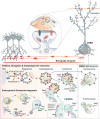Autophagy and the endolysosomal system in presynaptic function
- PMID: 33340068
- PMCID: PMC8004491
- DOI: 10.1007/s00018-020-03722-5
Autophagy and the endolysosomal system in presynaptic function
Abstract
The complex morphology of neurons, the specific requirements of synaptic neurotransmission and the accompanying metabolic demands create a unique challenge for proteostasis. The main machineries for neuronal protein synthesis and degradation are localized in the soma, while synaptic junctions are found at vast distances from the cell body. Sophisticated mechanisms must, therefore, ensure efficient delivery of newly synthesized proteins and removal of faulty proteins. These requirements are exacerbated at presynaptic sites, where the demands for protein turnover are especially high due to synaptic vesicle release and recycling that induces protein damage in an intricate molecular machinery, and where replacement of material is hampered by the extreme length of the axon. In this review, we will discuss the contribution of the two major pathways in place, autophagy and the endolysosomal system, to presynaptic protein turnover and presynaptic function. Although clearly different in their biogenesis, both pathways are characterized by cargo collection and transport into distinct membrane-bound organelles that eventually fuse with lysosomes for cargo degradation. We summarize the available evidence with regard to their degradative function, their regulation by presynaptic machinery and the cargo for each pathway. Finally, we will discuss the interplay of both pathways in neurons and very recent findings that suggest non-canonical functions of degradative organelles in synaptic signalling and plasticity.
Keywords: Autophagy; Axonal boutons; Endolysosomal system; Proteostasis; Synaptic plasticity.
Conflict of interest statement
All authors have read the manuscript and have no competing interests.
Figures



Similar articles
-
The needs of a synapse-How local organelles serve synaptic proteostasis.EMBO J. 2022 Apr 4;41(7):e110057. doi: 10.15252/embj.2021110057. Epub 2022 Mar 14. EMBO J. 2022. PMID: 35285533 Free PMC article. Review.
-
Local regulation of extracellular vesicle traffic by the synaptic endocytic machinery.J Cell Biol. 2022 May 2;221(5):e202112094. doi: 10.1083/jcb.202112094. Epub 2022 Mar 23. J Cell Biol. 2022. PMID: 35320349 Free PMC article.
-
Presynaptic Biogenesis Requires Axonal Transport of Lysosome-Related Vesicles.Neuron. 2018 Sep 19;99(6):1216-1232.e7. doi: 10.1016/j.neuron.2018.08.004. Epub 2018 Aug 30. Neuron. 2018. PMID: 30174114
-
Light-Activated ROS Production Induces Synaptic Autophagy.J Neurosci. 2019 Mar 20;39(12):2163-2183. doi: 10.1523/JNEUROSCI.1317-18.2019. Epub 2019 Jan 17. J Neurosci. 2019. PMID: 30655355 Free PMC article.
-
A Presynaptic Perspective on Transport and Assembly Mechanisms for Synapse Formation.Neuron. 2021 Jan 6;109(1):27-41. doi: 10.1016/j.neuron.2020.09.038. Epub 2020 Oct 23. Neuron. 2021. PMID: 33098763 Review.
Cited by
-
Fiber-based in vivo imaging: unveiling avenues for exploring mechanisms of synaptic plasticity and neuronal adaptations underlying behavior.Neurophotonics. 2024 Sep;11(Suppl 1):S11507. doi: 10.1117/1.NPh.11.S1.S11507. Epub 2024 Feb 22. Neurophotonics. 2024. PMID: 38390518 Free PMC article.
-
Neuronal-specific septin-3 binds Atg8/LC3B, accumulates and localizes to autophagosomes during induced autophagy.Cell Mol Life Sci. 2022 Aug 6;79(9):471. doi: 10.1007/s00018-022-04488-8. Cell Mol Life Sci. 2022. PMID: 35932293 Free PMC article.
-
Presynaptic autophagy is coupled to the synaptic vesicle cycle via ATG-9.Neuron. 2022 Mar 2;110(5):824-840.e10. doi: 10.1016/j.neuron.2021.12.031. Epub 2022 Jan 21. Neuron. 2022. PMID: 35065714 Free PMC article.
-
Autophagy in Human Retinal Neurons in Glaucoma.Bull Exp Biol Med. 2022 Aug;173(4):468-474. doi: 10.1007/s10517-022-05563-7. Epub 2022 Sep 5. Bull Exp Biol Med. 2022. PMID: 36058974
-
Dying by fire: noncanonical functions of autophagy proteins in neuroinflammation and neurodegeneration.Neural Regen Res. 2022 Feb;17(2):246-250. doi: 10.4103/1673-5374.317958. Neural Regen Res. 2022. PMID: 34269183 Free PMC article. Review.
References
Publication types
MeSH terms
Substances
Grants and funding
LinkOut - more resources
Full Text Sources

